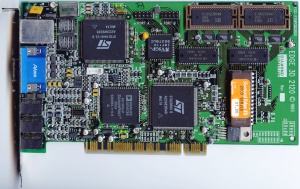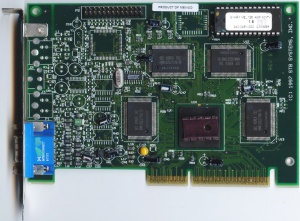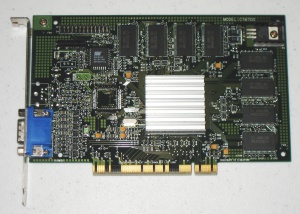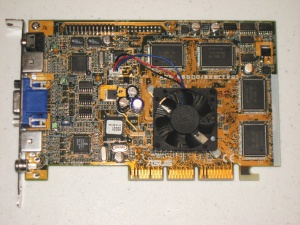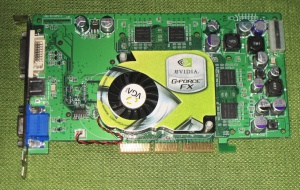NVIDIA
Contents
Retro value
GeForce 256 through GeForce FX are fine cards for old games for a number of reasons. Their DOS game compatibility and GUI performance are top notch. Their Direct3D driver supports two critical old features, fog table and 8-bit palettized textures. OpenGL compatibility and performance are second to none, and some games utilize proprietary NVIDIA extensions.
One problem with NVIDIA cards prior to GeForce4 is that some card vendors built their cards too cheaply. The most noticeable result is poor analog signal quality. It causes problems such as blurriness, loss of color saturation and color bleed, particularly at higher resolutions and refresh rates. Determining which cards are high quality is difficult but the GeForce4 and newer cards are most likely to be good.
Perhaps the finest choices are the GeForce FX series because they offer the most refined quality-enhancing features and the upper models have the performance to use these features at higher resolutions. GeForce 6 drops support for pallettized textures, which is a problem with a few games, but otherwise they too are great choices. GeForce 7 drops support for Windows 9x but still supports 2000. GF8+ only support XP and newer.
Cards
NV1 / STG2000
NVIDIA's first 3D accelerator was an all-in-one product with audio, GUI, VGA, 3D and Sega Saturn gamepad support. It uses a type of 3D rendering called quadratic texture mapping that is not Direct3D or OpenGL compatible so it is only useful with games that use its proprietary API. It is the same technology used by Sega Saturn and as such various games were ported to use the NV1. Its audio consists of wavetable MIDI and DirectSound support but very little DOS support. DOS VGA compatibility is limited.
It comes in various memory configurations with 4MB maximum.
Games with support: Battle Arena Toshinden, Descent: Destination Saturn, NASCAR Racing, Panzer Dragoon, Virtua Cop, Virtua Fighter Remix.
NV3 | RIVA 128 & 128 ZX
This chip is a 2D+3D GPU. It is essentially designed for Direct3D 5 but ok for OpenGL games too. It has some rendering quality issues like visible texture seams and a very apparent dithering pattern. It can only render at 16-bit color depth. It supports resolutions up to 960x720. Performance is competitive with Voodoo Graphics (Voodoo1).
RIVA 128 ZX is an upgraded chip that came later and supports 8MB RAM.
NV4-6 | RIVA TNT & TNT2
TNT is a drastically improved Direct3D 6-based GPU with much better image quality and performance. It is competitive with Voodoo2 but with more flexibility such as 32-bit color and larger texture support. 32-bit color imparts a significant speed loss though. 16MB RAM allows for very high resolutions. Great OpenGL support. All NVIDIA cards have the advantage of seperately clocked memory which makes for more flexible overclocking than with 3dfx cards.
TNT2 is very similar to the original TNT but it typically has 32MB of RAM and it is clocked much higher so performs noticeably better. Some popular budget variants include Vanta and TNT2 M64.
These cards do not support 8-bit palettized textures. This is a problem with, for example, Final Fantasy VII.
NV1x | GeForce 256 / 2 / 4 MX
GeForce 256 / NV10 was the first Direct3D 7 GPU. The DDR version is roughly twice as fast as TNT2. It has rudimentary rotated grid super-sampling anti-aliasing and basic anisotropic filtering support but neither are particularly useful.
GeForce 2 / NV15 has twice the texturing rate per clock of NV10 and so in addition to higher clock speeds it is a lot faster. These cards are often output a blurry image because of low quality analog circuit design.
GeForce4 MX / NV17 is in this family as well but it is highly refined and much more efficient. It has much lower potential throughput than the NV15 cards but is so much more efficient that it is competitive.
GF2 MX100 < GF2 MX200 < GF2 MX < GF2 MX400 < GF2 GTS < GF4 MX440 < GF2 Pro < GF2 Ti < GF2 Ultra
NV2x | GeForce 3 & 4
NV20 is GeForce 3, the first Direct3D 8 GPU. It is much more efficient than GeForce 2 so even though the GPUs have similar raw throughput the GeForce 3 can significantly win. It is the first with multi-sample anti-aliasing (MSAA) support and complete anisotropic filtering support. It also supports a special post-process blur filter called Quincunx anti-aliasing. Anisotropic has a major performance impact. Ti 200 is clocked lower than the original GeForce 3, while Ti 500 is fastest.
NV25 is GeForce 4 Ti and, while highly similar to GeForce3, it has higher clock speed and an additional vertex processor for better geometry performance. Ti 4200 is slowest, Ti 4800 is fastest.
NV3x | GeForce FX
These are NVIDIA's first Direct3D 9 GPUs. They have excellent Direct3D 5-8 compatibility and performance but are of limited value for Direct3D 9. They are very useful for old games because they still have support for palettized textures and fog table. Similar anti-aliasing and anisotropic features, but performance with these is improved compared to older models. The high performance models like 5700 Ultra, 5800 Ultra and 59x0 Ultra allow one to run old games in high-resolution with anti-aliasing and anisotropic filtering.
Avoid models with 64-bit bus and naming suffixes like LE, XT or VE because they have been crippled in some way. There were some PCIe models made, named GeForce PCX 5xxx.
5200 < 5500 < 5200 Ultra < 5600 < 5600 Ultra < 5700 < 5700 Ultra < 5800 < 5800 Ultra < 59x0 < 59x0 Ultra
NV4x | GeForce 6
Dramatically improved performance all-around but they drop palettized texture support so are incompatible with some old games (few). No new quality features. This is the final generation with Windows 9x support.
Compatibility notes
- With Intel 440BX motherboards, drivers newer than 56.64 may be unstable.
Video captures
